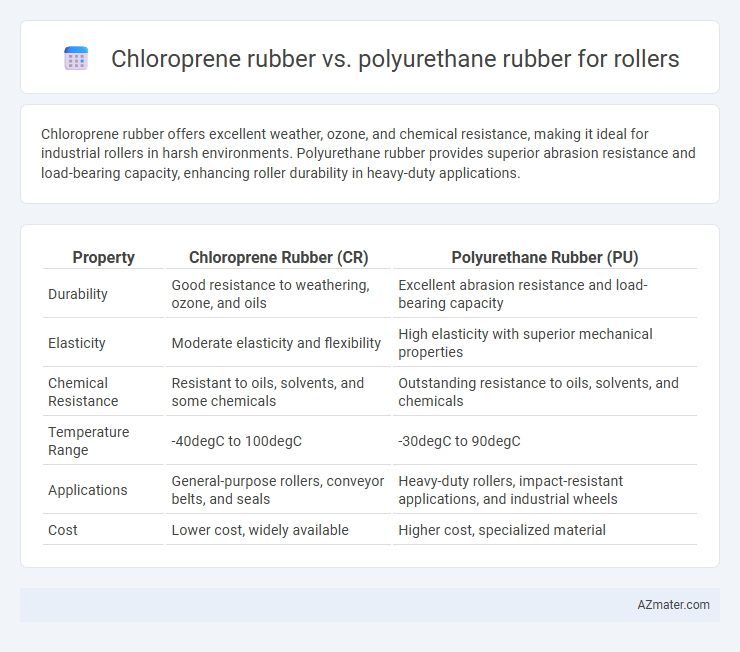Chloroprene rubber offers excellent weather, ozone, and chemical resistance, making it ideal for industrial rollers in harsh environments. Polyurethane rubber provides superior abrasion resistance and load-bearing capacity, enhancing roller durability in heavy-duty applications.
Table of Comparison
| Property | Chloroprene Rubber (CR) | Polyurethane Rubber (PU) |
|---|---|---|
| Durability | Good resistance to weathering, ozone, and oils | Excellent abrasion resistance and load-bearing capacity |
| Elasticity | Moderate elasticity and flexibility | High elasticity with superior mechanical properties |
| Chemical Resistance | Resistant to oils, solvents, and some chemicals | Outstanding resistance to oils, solvents, and chemicals |
| Temperature Range | -40degC to 100degC | -30degC to 90degC |
| Applications | General-purpose rollers, conveyor belts, and seals | Heavy-duty rollers, impact-resistant applications, and industrial wheels |
| Cost | Lower cost, widely available | Higher cost, specialized material |
Introduction to Roller Materials: Chloroprene Rubber vs Polyurethane Rubber
Chloroprene rubber offers excellent chemical resistance and moderate abrasion resistance, making it ideal for rollers in environments exposed to oils and solvents. Polyurethane rubber provides superior abrasion resistance and load-bearing capacity, enhancing roller durability in high-wear industrial applications. Selecting between chloroprene and polyurethane depends on operational demands such as chemical exposure and mechanical stress tolerance.
Chemical Structure and Composition
Chloroprene rubber (CR) features a polychloroprene backbone with chlorine atoms imparting superior chemical resistance and flame retardancy, making it ideal for rollers exposed to oils and chemicals. Polyurethane rubber (PU) consists of segmented copolymers formed by the reaction of diisocyanates with polyols, offering exceptional abrasion resistance and mechanical strength for high-wear roller applications. The presence of chlorine in CR enhances its weather resistance, while the urethane linkages in PU provide flexibility and resilience under dynamic loads.
Mechanical Properties Comparison
Chloroprene rubber offers superior abrasion resistance and good tensile strength, making it ideal for rollers subjected to high wear and moderate mechanical stress. Polyurethane rubber provides higher tear resistance and exceptional load-bearing capacity, which enhances durability under heavy mechanical loads and repeated compressive forces. Both materials exhibit excellent elasticity, but polyurethane's superior elongation at break supports enhanced flexibility for dynamic roller applications.
Abrasion and Wear Resistance
Chloroprene rubber exhibits excellent abrasion resistance and moderate wear resistance, making it suitable for rollers subjected to moderate mechanical stress and chemical exposure. Polyurethane rubber outperforms chloroprene in wear resistance, offering superior durability, higher load-bearing capacity, and enhanced resistance to cuts and tears, ideal for heavy-duty roller applications. Choosing polyurethane over chloroprene ensures prolonged roller lifespan and reduced maintenance in abrasive environments.
Resistance to Chemicals and Oils
Chloroprene rubber exhibits excellent resistance to a wide range of chemicals, including acids, alkalis, and oils, making it ideal for rollers exposed to harsh industrial environments. Polyurethane rubber offers superior resistance to petroleum-based oils and lubricants, with enhanced abrasion and tear resistance, suitable for applications involving heavy mechanical stress. Choosing between Chloroprene and Polyurethane rubber depends on the specific chemical exposure and mechanical demands of the roller's operational environment.
Performance in Different Temperatures
Chloroprene rubber exhibits excellent performance in a temperature range of -40degC to 120degC, maintaining flexibility and resistance to weathering, ozone, and chemicals, making it suitable for rollers exposed to varying environmental conditions. Polyurethane rubber offers superior abrasion resistance and mechanical strength, performing well between -30degC and 85degC but may harden or lose elasticity outside this range, affecting roller efficiency. Selecting between chloroprene and polyurethane depends on the specific temperature demands and wear conditions of the roller application.
Applications and Industry Use Cases
Chloroprene rubber offers excellent oil resistance, aging stability, and moderate mechanical strength, making it ideal for rollers in automotive, printing, and conveyor applications where durability against chemicals and weathering is critical. Polyurethane rubber excels in abrasion resistance, load-bearing capacity, and elasticity, commonly used in heavy-duty industrial rollers for material handling, packaging, and textile machinery requiring high wear and tear resilience. Industries such as manufacturing, logistics, and paper production leverage chloroprene for its chemical resilience, while polyurethane is favored in abrasive environments demanding prolonged service life.
Cost-Effectiveness and Lifecycle
Chloroprene rubber offers moderate cost-effectiveness with strong resistance to oils, ozone, and weathering, making it suitable for rollers in industrial environments requiring durability and moderate lifespan. Polyurethane rubber, although initially more expensive, provides superior wear resistance and longer lifecycle performance, reducing replacement frequency and overall maintenance costs in high-abrasion roller applications. Evaluating total cost of ownership favors polyurethane for heavy-duty operations due to its enhanced durability despite higher upfront investment.
Maintenance and Longevity
Chloroprene rubber offers excellent resistance to oils, chemicals, and weathering, resulting in lower maintenance requirements and enhanced durability for rollers in industrial settings. Polyurethane rubber provides superior abrasion resistance and load-bearing capacity, extending roller lifespan under heavy mechanical stress but may require more frequent inspection to prevent hydrolysis-related degradation. Choosing between chloroprene and polyurethane depends on the specific operational environment, balancing chemical resilience against mechanical wear for optimal roller maintenance and longevity.
Choosing the Right Rubber for Roller Applications
Chloroprene rubber offers excellent oil, weather, and abrasion resistance, making it ideal for heavy-duty roller applications in harsh environments, while polyurethane rubber provides superior load-bearing capacity, tear strength, and chemical resistance for high-performance rollers in precision industries. Selecting the right rubber depends on the specific demands of the application, such as exposure to chemicals, required durability, and mechanical stress. Polyurethane excels in applications needing high resilience and wear resistance, whereas chloroprene is preferred for balanced performance in moderate chemical and environmental exposure.

Infographic: Chloroprene rubber vs Polyurethane rubber for Roller
 azmater.com
azmater.com